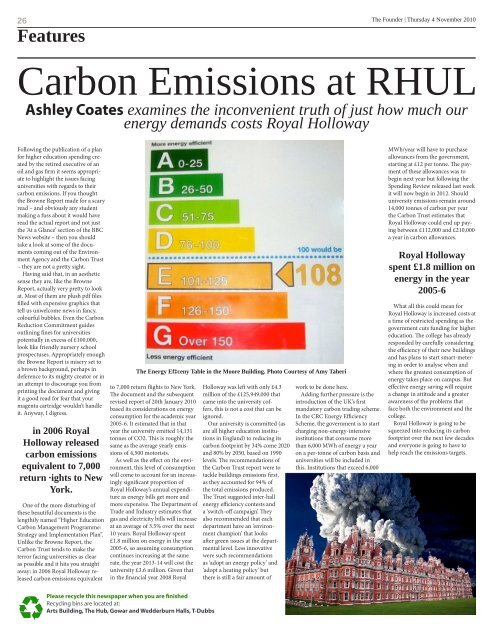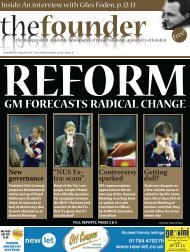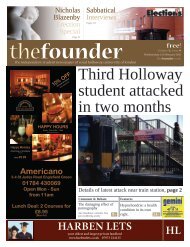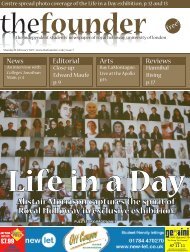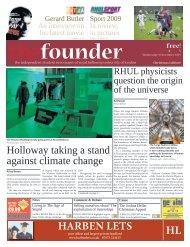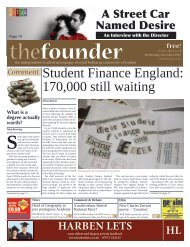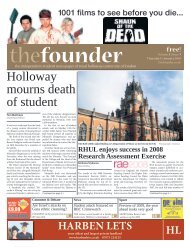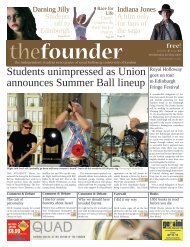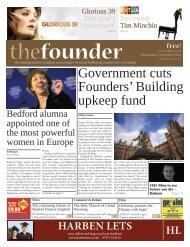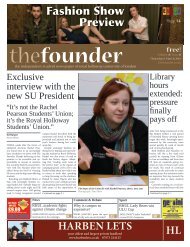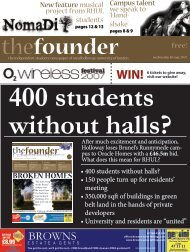The Founder Volume 5 Issue 4
The Founder Volume 5 Issue 4
The Founder Volume 5 Issue 4
Create successful ePaper yourself
Turn your PDF publications into a flip-book with our unique Google optimized e-Paper software.
26 <strong>The</strong> <strong>Founder</strong> | Thursday 4 November 2010<br />
Features<br />
Carbon Emissions at RHUL<br />
Ashley Coates examines the inconvenient truth of just how much our<br />
energy demands costs Royal Holloway<br />
Following the publication of a plan<br />
for higher education spending created<br />
by the retired executive of an<br />
oil and gas firm it seems appropriate<br />
to highlight the issues facing<br />
universities with regards to their<br />
carbon emissions. If you thought<br />
the Browne Report made for a scary<br />
read – and obviously any student<br />
making a fuss about it would have<br />
read the actual report and not just<br />
the ‘At a Glance’ section of the BBC<br />
News website – then you should<br />
take a look at some of the documents<br />
coming out of the Environment<br />
Agency and the Carbon Trust<br />
– they are not a pretty sight.<br />
Having said that, in an aesthetic<br />
sense they are, like the Browne<br />
Report, actually very pretty to look<br />
at. Most of them are plush pdf files<br />
filled with expensive graphics that<br />
tell us unwelcome news in fancy,<br />
colourful bubbles. Even the Carbon<br />
Reduction Commitment guides<br />
outlining fines for universities<br />
potentially in excess of £100,000,<br />
look like friendly nursery school<br />
prospectuses. Appropriately enough<br />
the Browne Report is misery set to<br />
a brown background, perhaps in<br />
deference to its mighty creator or in<br />
an attempt to discourage you from<br />
printing the document and giving<br />
it a good read for fear that your<br />
magenta cartridge wouldn’t handle<br />
it. Anyway, I digress.<br />
in 2006 Royal<br />
Holloway released<br />
carbon emissions<br />
equivalent to 7,000<br />
return flights to New<br />
York.<br />
One of the more disturbing of<br />
these beautiful documents is the<br />
lengthily named “Higher Education<br />
Carbon Management Programme:<br />
Strategy and Implementation Plan”.<br />
Unlike the Browne Report, the<br />
Carbon Trust tends to make the<br />
terror facing universities as clear<br />
as possible and it hits you straight<br />
away: in 2006 Royal Holloway released<br />
carbon emissions equivalent<br />
<strong>The</strong> Energy Efficeny Table in the Moore Building. Photo Courtesy of Amy Taheri<br />
to 7,000 return flights to New York.<br />
<strong>The</strong> document and the subsequent<br />
revised report of 20th January 2010<br />
based its considerations on energy<br />
consumption for the academic year<br />
2005-6. It estimated that in that<br />
year the university emitted 14,131<br />
tonnes of CO2. This is roughly the<br />
same as the average yearly emissions<br />
of 4,500 motorists.<br />
As well as the effect on the environment,<br />
this level of consumption<br />
will come to account for an increasingly<br />
significant proportion of<br />
Royal Holloway’s annual expenditure<br />
as energy bills get more and<br />
more expensive. <strong>The</strong> Department of<br />
Trade and Industry estimates that<br />
gas and electricity bills will increase<br />
at an average of 3.5% over the next<br />
10 years. Royal Holloway spent<br />
£1.8 million on energy in the year<br />
2005-6, so assuming consumption<br />
continues increasing at the same<br />
rate, the year 2013-14 will cost the<br />
university £3.6 million. Given that<br />
in the financial year 2008 Royal<br />
Holloway was left with only £4.3<br />
million of the £125,949,000 that<br />
came into the university coffers,<br />
this is not a cost that can be<br />
ignored.<br />
Our university is committed (as<br />
are all higher education institutions<br />
in England) to reducing its<br />
carbon footprint by 34% come 2020<br />
and 80% by 2050, based on 1990<br />
levels. <strong>The</strong> recommendations of<br />
the Carbon Trust report were to<br />
tackle buildings emissions first,<br />
as they accounted for 94% of<br />
the total emissions produced.<br />
<strong>The</strong> Trust suggested inter-hall<br />
energy efficiency contests and<br />
a ‘switch-off campaign’. <strong>The</strong>y<br />
also recommended that each<br />
department have an ‘environment<br />
champion’ that looks<br />
after green issues at the departmental<br />
level. Less innovative<br />
were such recommendations<br />
as ‘adopt an energy policy’ and<br />
‘adopt a heating policy’ but<br />
there is still a fair amount of<br />
work to be done here.<br />
Adding further pressure is the<br />
introduction of the UK’s first<br />
mandatory carbon trading scheme.<br />
In the CRC Energy Efficiency<br />
Scheme, the government is to start<br />
charging non-energy-intensive<br />
institutions that consume more<br />
than 6,000 MWh of energy a year<br />
on a per-tonne of carbon basis and<br />
universities will be included in<br />
this. Institutions that exceed 6,000<br />
MWh/year will have to purchase<br />
allowances from the government,<br />
starting at £12 per tonne. <strong>The</strong> payment<br />
of these allowances was to<br />
begin next year but following the<br />
Spending Review released last week<br />
it will now begin in 2012. Should<br />
university emissions remain around<br />
14,000 tonnes of carbon per year<br />
the Carbon Trust estimates that<br />
Royal Holloway could end up paying<br />
between £112,000 and £210,000<br />
a year in carbon allowances.<br />
Royal Holloway<br />
spent £1.8 million on<br />
energy in the year<br />
2005-6<br />
What all this could mean for<br />
Royal Holloway is increased costs at<br />
a time of restricted spending as the<br />
government cuts funding for higher<br />
education. <strong>The</strong> college has already<br />
responded by carefully considering<br />
the efficiency of their new buildings<br />
and has plans to start smart-metering<br />
in order to analyse when and<br />
where the greatest consumption of<br />
energy takes place on campus. But<br />
effective energy saving will require<br />
a change in attitude and a greater<br />
awareness of the problems that<br />
face both the environment and the<br />
college.<br />
Royal Holloway is going to be<br />
squeezed into reducing its carbon<br />
footprint over the next few decades<br />
and everyone is going to have to<br />
help reach the emissions targets.<br />
Please recycle this newspaper when you are finished<br />
Recycling bins are located at:<br />
Arts Building, <strong>The</strong> Hub, Gowar and Wedderburn Halls, T-Dubbs


